嵌入式系统移植之Linux内核移植
移植linux内核 v5.4.79
1. 在linux官网下载 https://www.kernel.org/
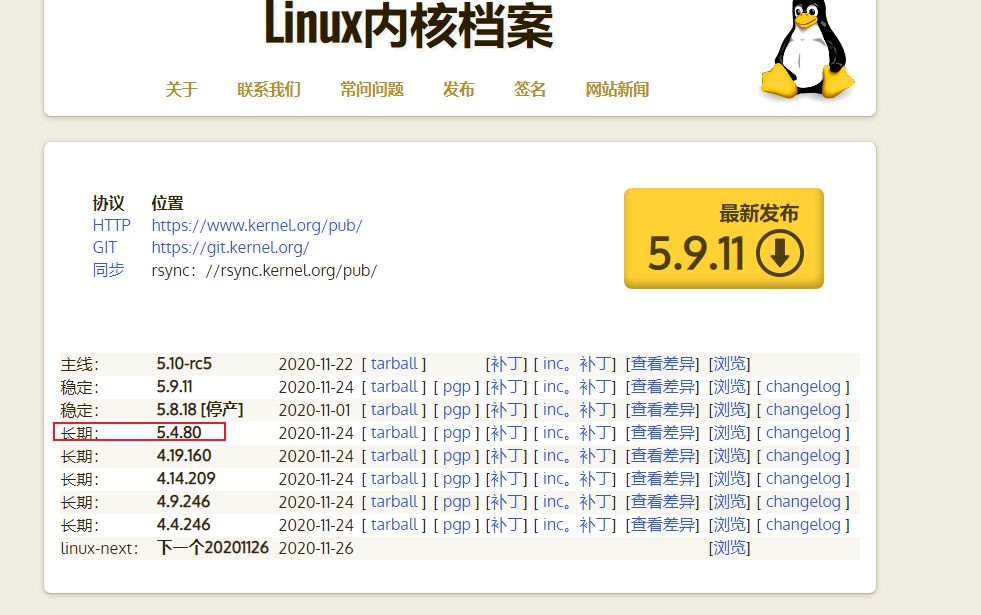
2. tar -vxf 解压
3. 进入arch/arm/configs文件夹 查找适配开发板的config文件。

4. 清除原配置,配置Makefile make ARCH=arm distclean 修改 源码顶层目录的 Makfile ARCH ?= arm CROSS_COMPILE ?= arm-none-linux-gnueabi-
5. 导入配置(配置列表见 arch/arm/configs/ 找最类似的) 不修改linux-5.4.79/Makefile 直接执行 make ARCH=arm exynos_defconfig 此处可能会因为缺少安装包而报错,对应处理方案如下: 问题1:缺少flex /bin/sh: 1: flex: not found scripts/Makefile.host:9: recipe for target 'scripts/kconfig/lexer.lex.c' failed make[1]: *** [scripts/kconfig/lexer.lex.c] Error 127 Makefile:590: recipe for target 'exynos_defconfig' failed make: *** [exynos_defconfig] Error 2 解决方案: apt-get install flex 问题2: 缺少bison /bin/sh: 1: bison: not found scripts/Makefile.host:17: recipe for target 'scripts/kconfig/parser.tab.h' failed make[1]: *** [scripts/kconfig/parser.tab.h] Error 127 Makefile:590: recipe for target 'exynos_defconfig' failed make: *** [exynos_defconfig] Error 2 解决方案: sudo apt-get install bison
6. 配置内核 make ARCH=arm menuconfig 此处可能会因为缺少安装包而报错,对应处理方案如下: 错误1: scripts/kconfig/Makefile:208: recipe for target 'scripts/kconfig/mconf-cfg' failed make[1]: *** [scripts/kconfig/mconf-cfg] Error 1 Makefile:591: recipe for target 'menuconfig' failed make: *** [menuconfig] Error 2 解决方案: sudo apt-get install ncurses-dev System Type ---> [*] Samsung EXYNOS ---> [ ] SAMSUNG EXYNOS3 [*] SAMSUNG EXYNOS4 [ ] SAMSUNG EXYNOS5 *** EXYNOS SoCs *** -*- SAMSUNG EXYNOS4210 [ ] SAMSUNG EXYNOS4212 [*] SAMSUNG EXYNOS4412 [ ] SAMSUNG EXYNOS4415 退出 保存
7. 编译内核 uImage make -j6 ARCH=arm CROSS_COMPILE=arm-none-linux-gnueabi- 编译将会生成 zImage 进入目录 linux-5.4.79/arch/arm/boot 执行命令将 zImage 制作成 uImage mkimage -A arm -O linux -T kernel -C none -a 0x41000000 -e 0x41000040 -n "aaa" -d zImage uImage 此处可能会因为缺少安装包而报错,对应处理方案如下: 错误1: scripts/extract-cert.c:21:10: fatal error: openssl/bio.h: No such file or directory #include <openssl/bio.h> ^~~~~~~~~~~~~~~ compilation terminated. scripts/Makefile.host:107: recipe for target 'scripts/extract-cert' failed make[1]: *** [scripts/extract-cert] Error 1 Makefile:1124: recipe for target 'scripts' failed make: *** [scripts] Error 2 解决方案: sudo apt install libssl-dev 错误2:没有配置写入地址 This is incompatible with uImages Specify LOADADDR on the commandline to build an uImage arch/arm/boot/Makefile:90: recipe for target 'arch/arm/boot/uImage' failed make[1]: *** [arch/arm/boot/uImage] Error 1 arch/arm/Makefile:342: recipe for target 'uImage' failed make: *** [uImage] Error 2 解决方案:注意该地址应与 开发板pri环境变量中指定uImage位置相匹配 make uImage LOADADDR=0x41000000
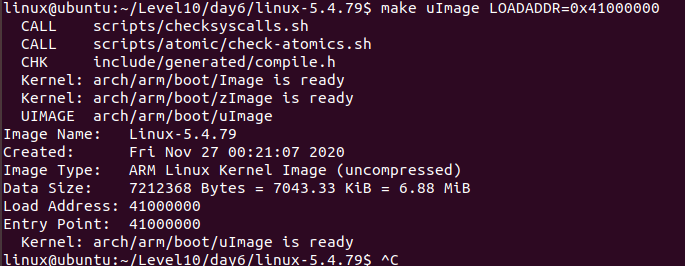
8. 编译设备树 make ARCH=arm dtbs
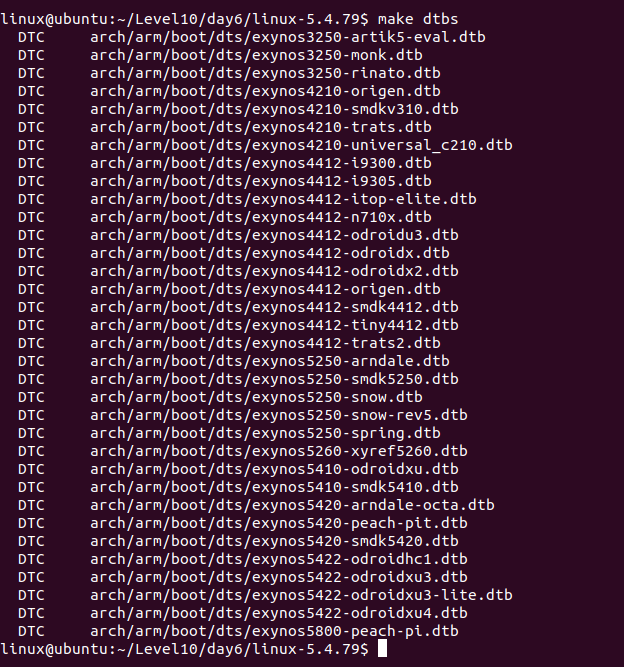
9. 上传到NAS,观测效果。
使用 linux-5.4.79/arch/arm/boot/uImage 和
linux-5.4.79/arch/arm/boot/dts/exynos4412-origen.dtb
至此没有异常的话可以正常启动 linux,
但是挂载不了根文件系统,因为没有配置网卡驱动
10. 配置网卡驱动 make ARCH=arm menuconfig [*] Networking support ---> Networking options ---> <*> Packet socket <*>Unix domain sockets [*] TCP/IP networking [*] IP: kernel level autoconfiguration Device Drivers ---> [*] Network device support ---> [*] Ethernet driver support (NEW) ---> <*> DM9000 support File systems ---> [*] Network File Systems (NEW) ---> <*> NFS client support [*] NFS client support for NFS version 3 [*] NFS client support for the NFSv3 ACL protocol extension [*] Root file system on NFS
11. 配置时钟 这部分不是必须修改的 要看内核,先执行上面9步,如无法正常启动, 并报错s5m-rtc s5m-rtc: hctosys: unable to read the hardware clock,可尝试一下修改: 修改文件driver/clk/clk.c static bool clk_ignore_unused; 改为static bool clk_ignore_unused = true;
12. 结果展示:
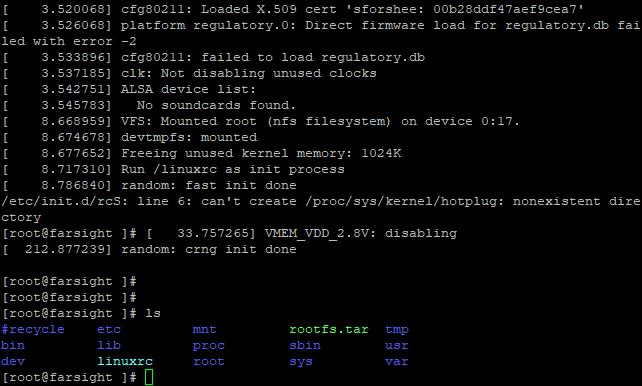
网卡移植之设备树信息分析
1.设备树简介
所谓设备树DeviceTree ,就是CPU与设备连接描述。
用于管理 硬件拓扑和硬件资源信息。
Device Tree由一系列被命名的结点(node)和属性(property)组成,而结点本身可包含子结点。
所谓属性,其实就是成对出现的name和value。
相关链接
Linux DTS(Device Tree Source)设备树详解之一(背景基础知识篇)
https://e-mailky.github.io/2019-01-14-dts-1
Linux DTS(Device Tree Source)设备树详解之二(dts匹配及发挥作用的流程篇)
https://e-mailky.github.io/2019-01-14-dts-2
Linux DTS(Device Tree Source)设备树详解之三(高通MSM8953实例分析篇)
https://e-mailky.github.io/2019-01-14-dts-3
2.平台设备
CPU与设备连接描述 - 平台设备
在内核里有一个结构“struct machine_desc”,内核用这个结构表示一个实际存在的板子,而针对每个板子都会有一个文件定义这个结构体,这个文件叫平台代码;
如:arch/arm/mach-s5pv21/mach-smdkv210.c(3.14版本内核中没有基于Exynos4412的平台代码,这里以s5pv210为例)
MACHINE_START(SMDKV210, "SMDKV210")
/* Maintainer: Kukjin Kim <kgene.kim@samsung.com> */
.atag_offset = 0x100,
.init_irq = s5pv210_init_irq,
.map_io = smdkv210_map_io,
.init_machine = smdkv210_machine_init,
.init_time = samsung_timer_init,
.restart = s5pv210_restart,
.reserve = &smdkv210_reserve,
MACHINE_END
5.4版本基于Exynos4412的平台代码如下:
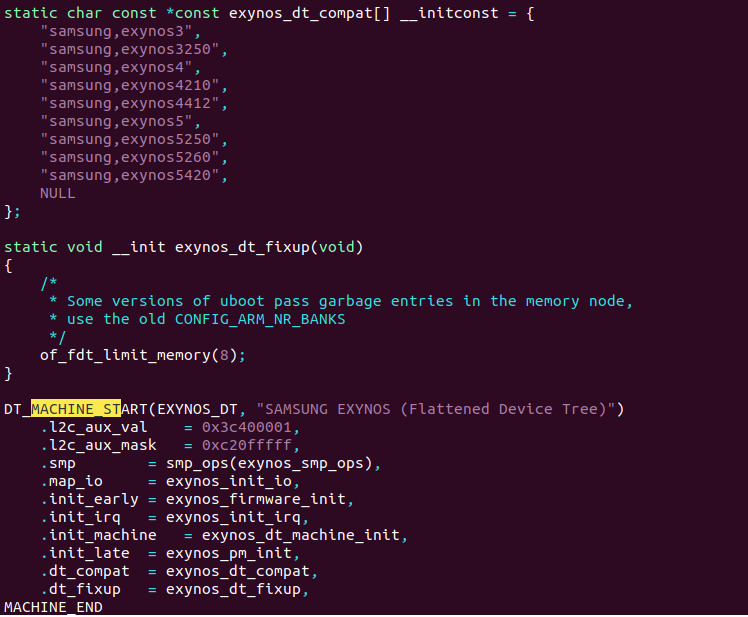
3.网卡移植 平台相关
srom-cs1@5000000 {
/* 第一部分 是描述CPU内部总线的信息 */
compatible = "simple-bus";
#address-cells = <1>;
#size-cells = <1>;
reg = <0x5000000 0x1000000>; //总线地址,总线长度
/* 以下为第二部分 是描述网卡信息 */
ethernet@5000000 {
compatible = "davicom,dm9000"; 内核通过该名字来匹配驱动
reg = <0x5000000 0x2 0x5000004 0x2>; 寄存器地址和数据宽度
interrupt-parent = <&gpx0>; 继承于 中断控制器gpx0
interrupts = <6 4>; 6 对应中断源 DM9000_IRQ -> XEINT6 。4对应 active high level-sensitive
davicom,no-eeprom;
mac-address = [00 0a 2d a6 55 a2];
};
/* 树状结构,如有必要, 可在这之下挂载更多的设备信息*/
};
-
总线地址 总线长度的确认
找到网卡芯片DM 9000 的电路图,找到片选CS#引脚对应的接口 BUF_Xm0cs1

继续在外围电路中搜索该引脚,发现接到了一颗转换芯片上,找到转换过后的接口 Xm0cs1
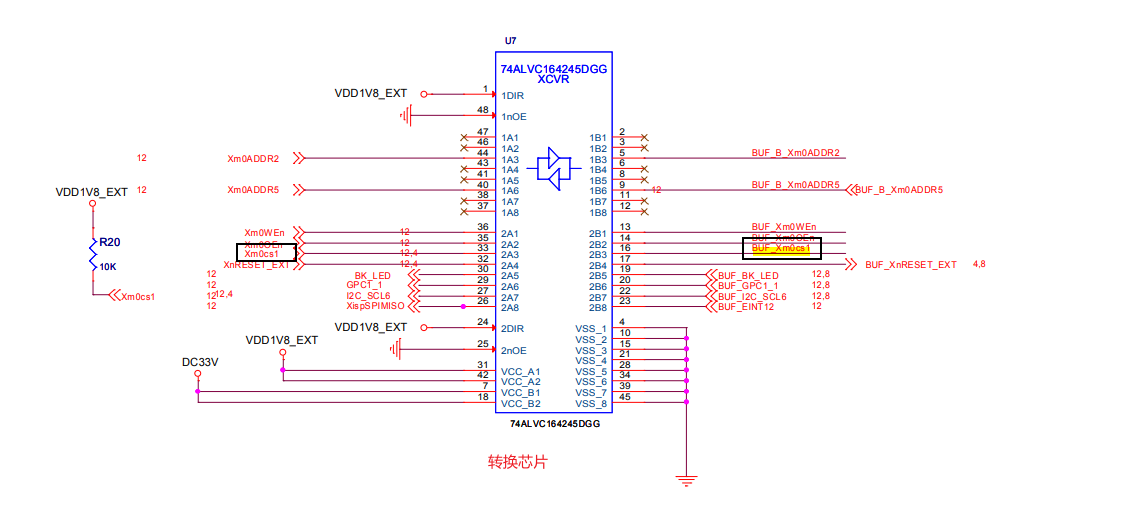
在外围电路图搜索该接口,发现已经没有了,在核心电路图上搜索该接口,找到CPU引脚Xm0CSn1
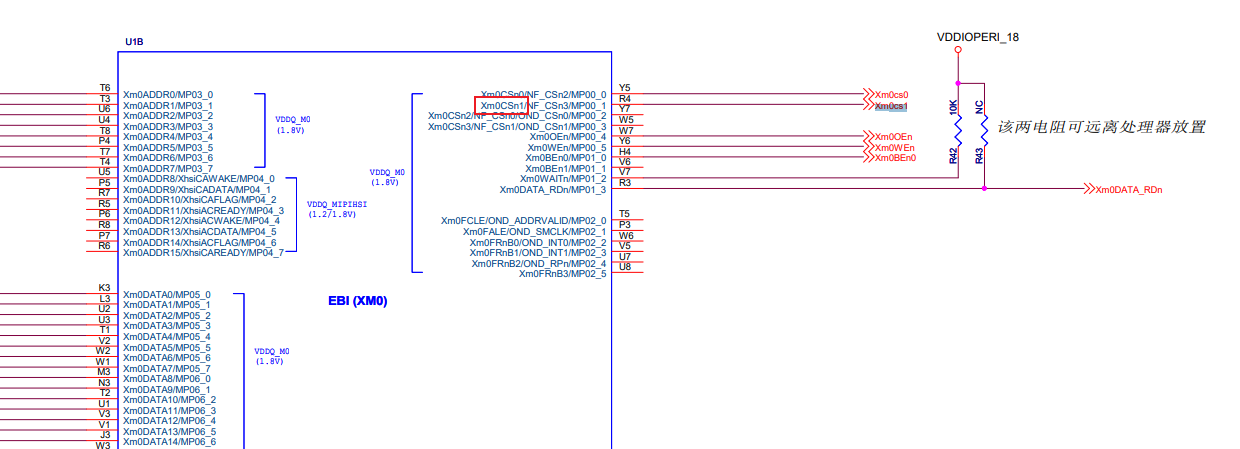
查4412三星手册,找到Xm0CSn_1对应的控制引脚GPY0_CON
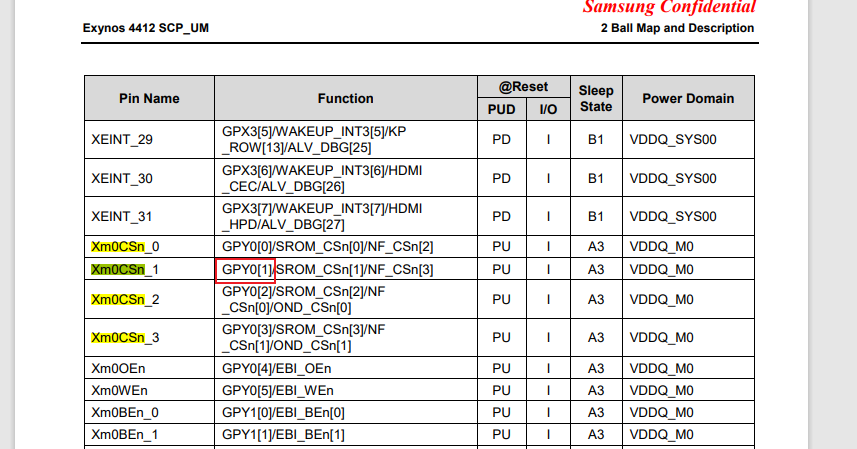
查找GPY0_CON,GPY0_CON[1] = 0x2 ,即可设置成SROM_CSN[1]模式
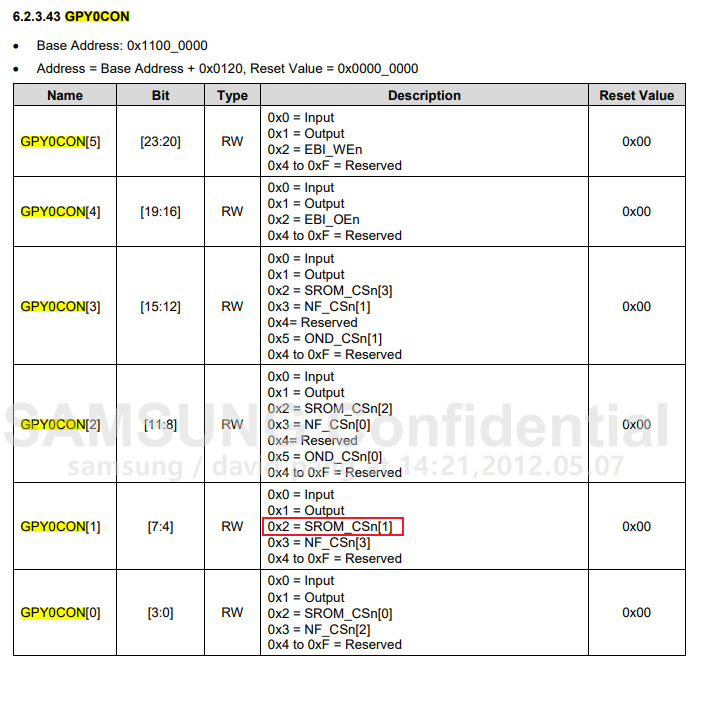
继续查找Xm0CSn_1,4412芯片通过一个SROM存储控制器链接DM900网卡。
值得注意的是,这个存储控制器SROM控制的是外部的存储器,DM900网卡内部包含了一个存储芯片,
用作缓冲区,换句话说,4412将DM900网卡看成了一个存储设备,而不是特化成网卡对待。
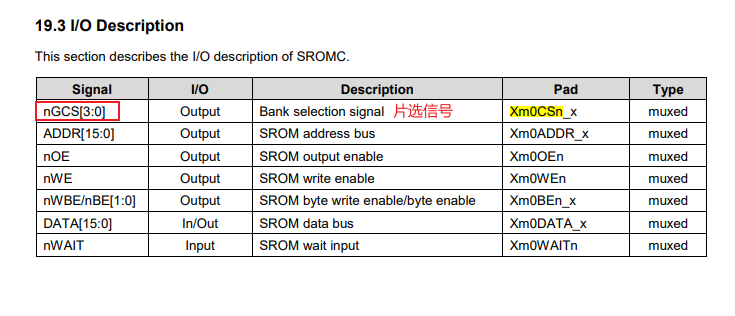
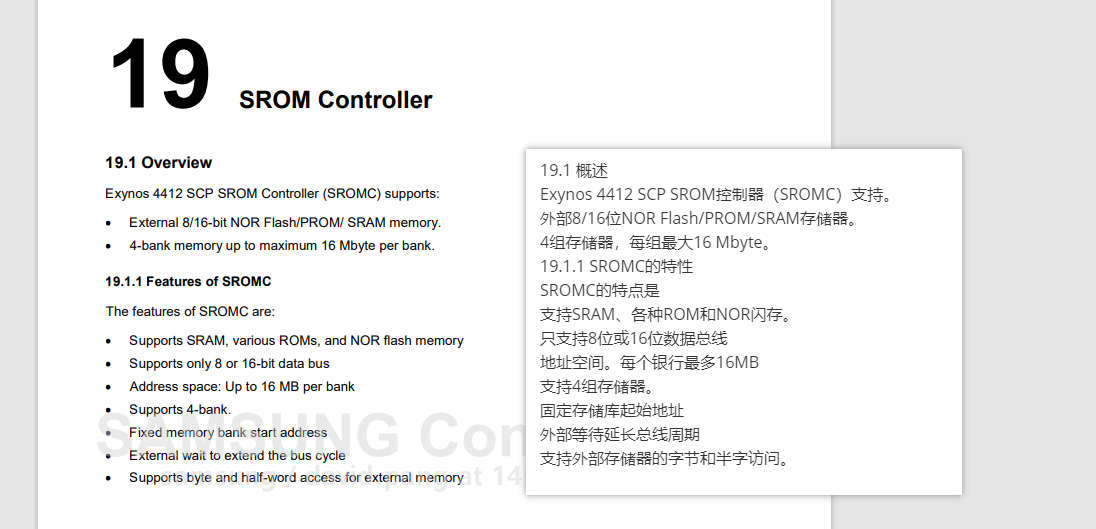
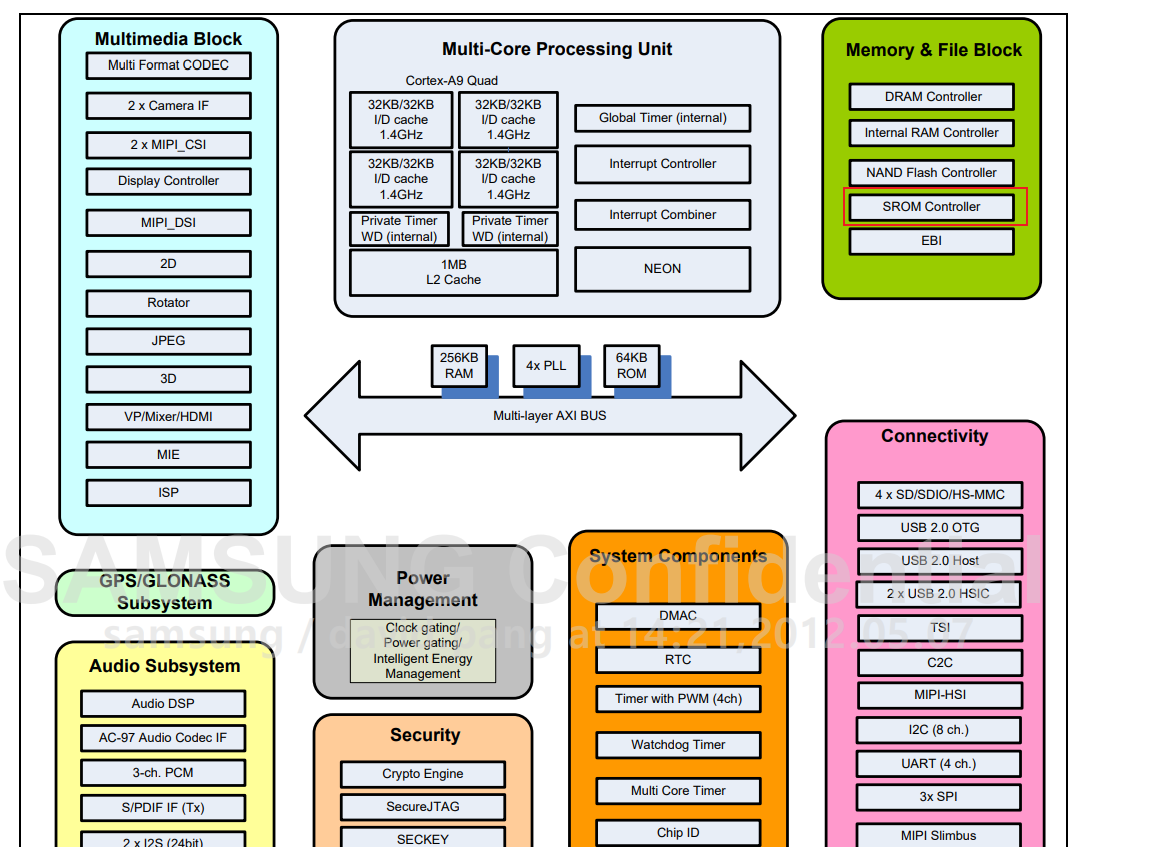
Xm0CSn1对应BANK1,查找内存映射Memory Map
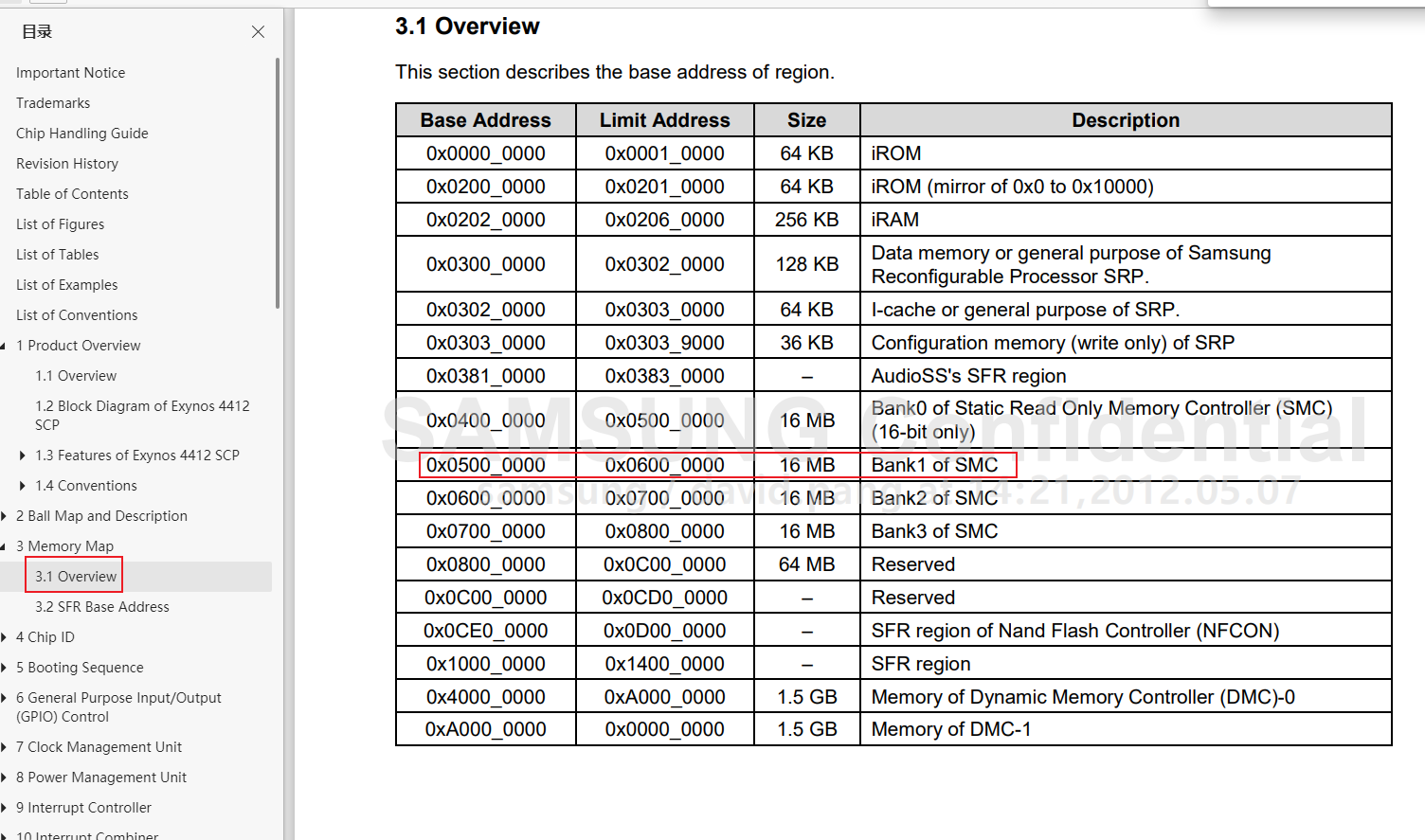
查表可知 基址0x0500_0000,极限地址0x0600_0000,长度0x0100_0000。
因此 第一部分 reg= <0x5000000 0x1000000>; -
描述网卡信息部分解析
首先到Documentation目录下查找网卡DM900的范例代码
在linux-5.4.79/Documentation/devicetree/bindings/net目录下 找到 davicom-dm9000.txt
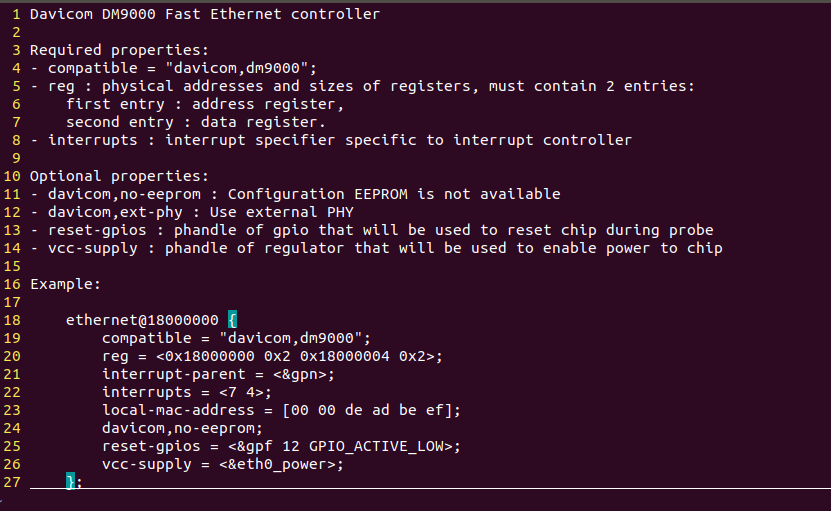
照着范例进行修改,第一行
compatible = "davicom,dm9000"; //内核通过该名字来匹配驱动
找到对应的驱动文件
/Level10/day6/linux-5.4.79/drivers/net/ethernet/davicom/dm9000.c
搜 compatible,数据保持一致就好。具体信息后续会深入研究。

reg = <0x5000000 0x2 0x5000004 0x2>; //寄存器地址和数据宽度
参考 davicom-dm9000.txt 中的-reg 描述。
0x2是则需要看下面的电路图,数据总线是16位就是0x2,如果是32位就是0x4,8位就是0x1.
reg = <0x18000000 0x2 0x18000004 0x2>; //照着这个修改地址得到
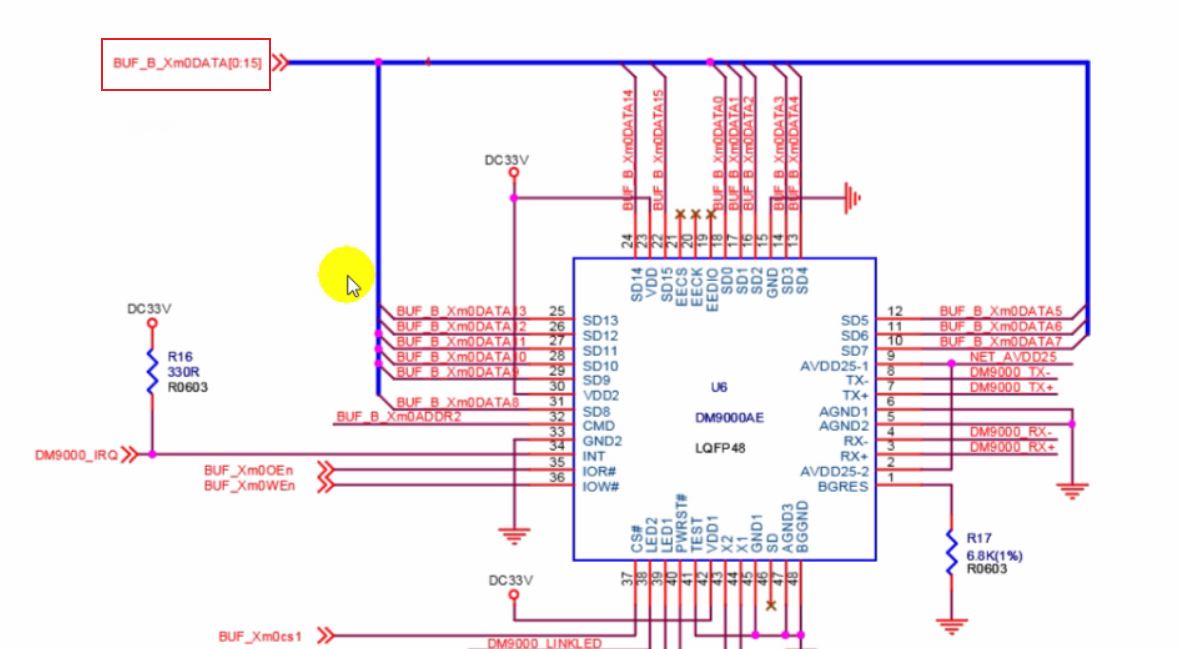
interrupt-parent = <&gpx0>; //继承于 中断控制器gpx0 存在的意义是利用中断提高网卡响应的实时性。
查看DM9000芯片的INT引脚,溯源到gpx0_6,写做<gpx0>,如果是gpx1_3 就是<&gpx1>以此类推
interrupts = <6 4>; //6 对应中断源 DM9000_IRQ -> XEINT6 。4对应 active high
这里的的6就是gpx0_6中的6,4表示高电平触发,和范例中保持一致,不动即可。
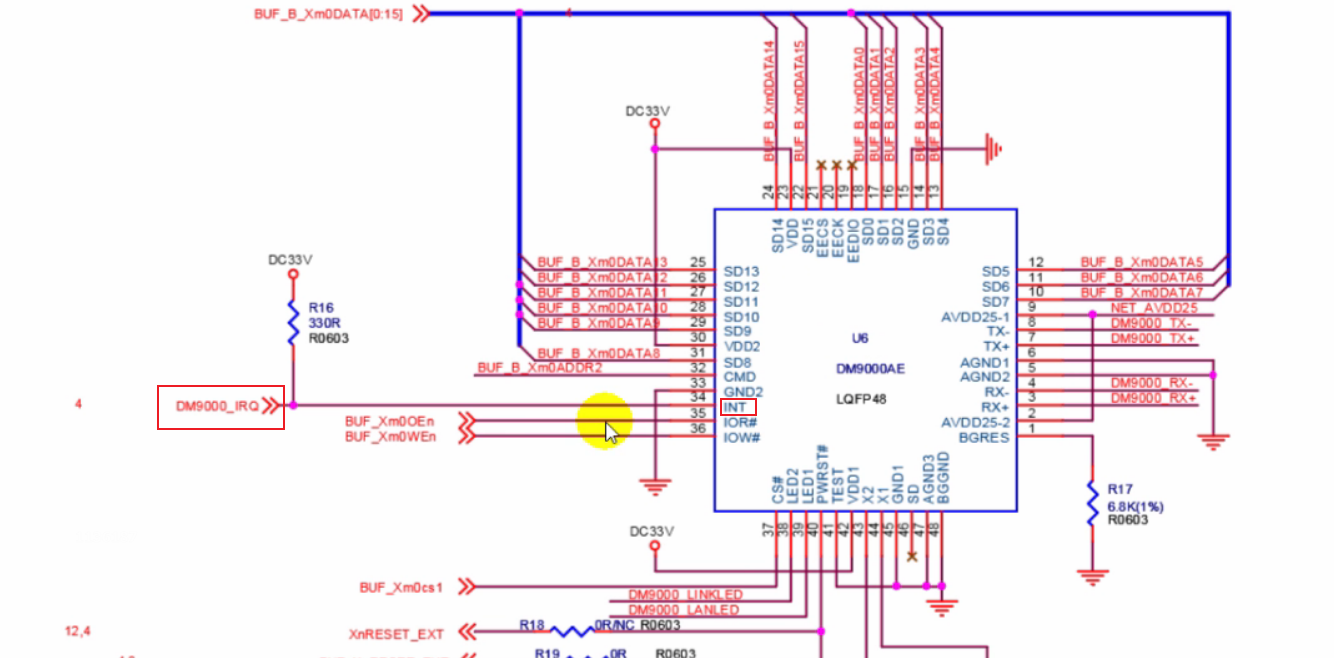

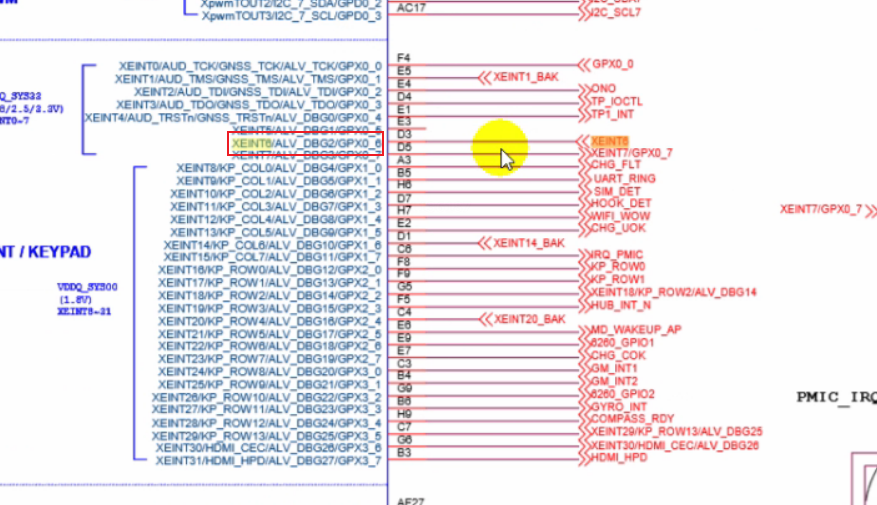
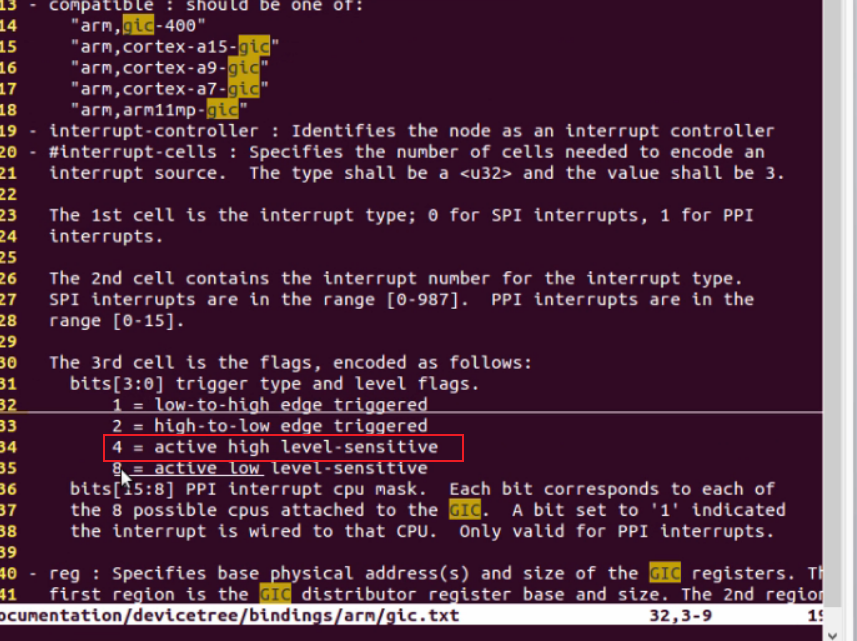
这俩保持不变即可。
davicom,no-eeprom;
mac-address = [00 0a 2d a6 55 a2]; //MAC地址